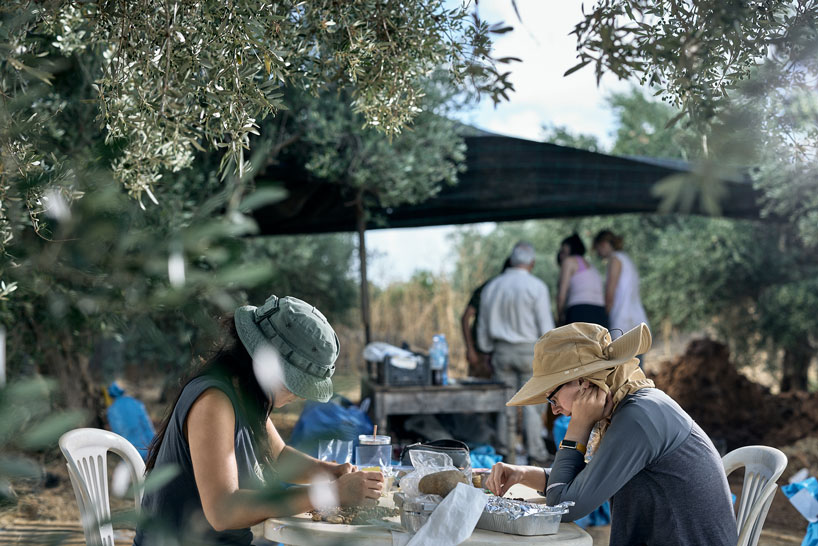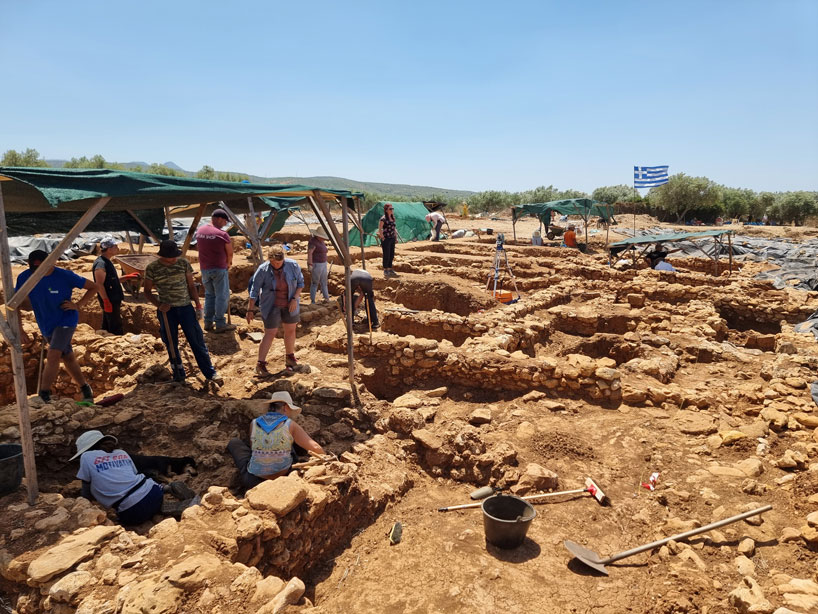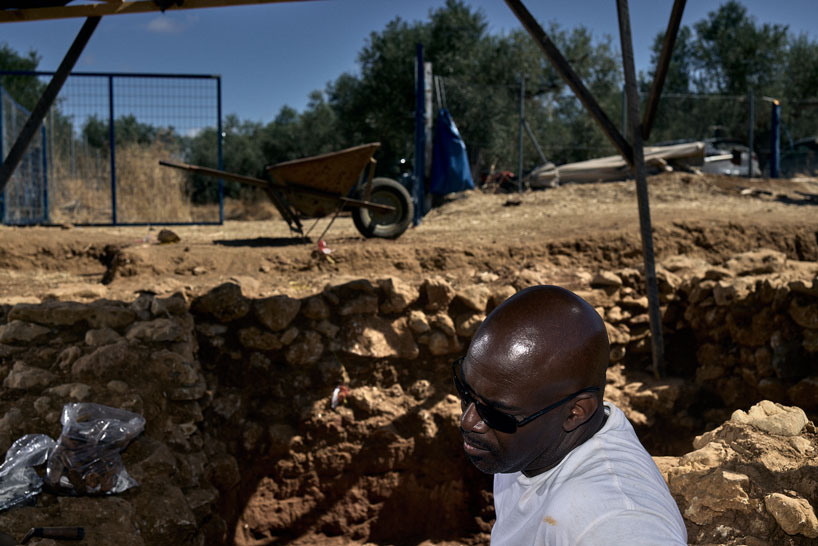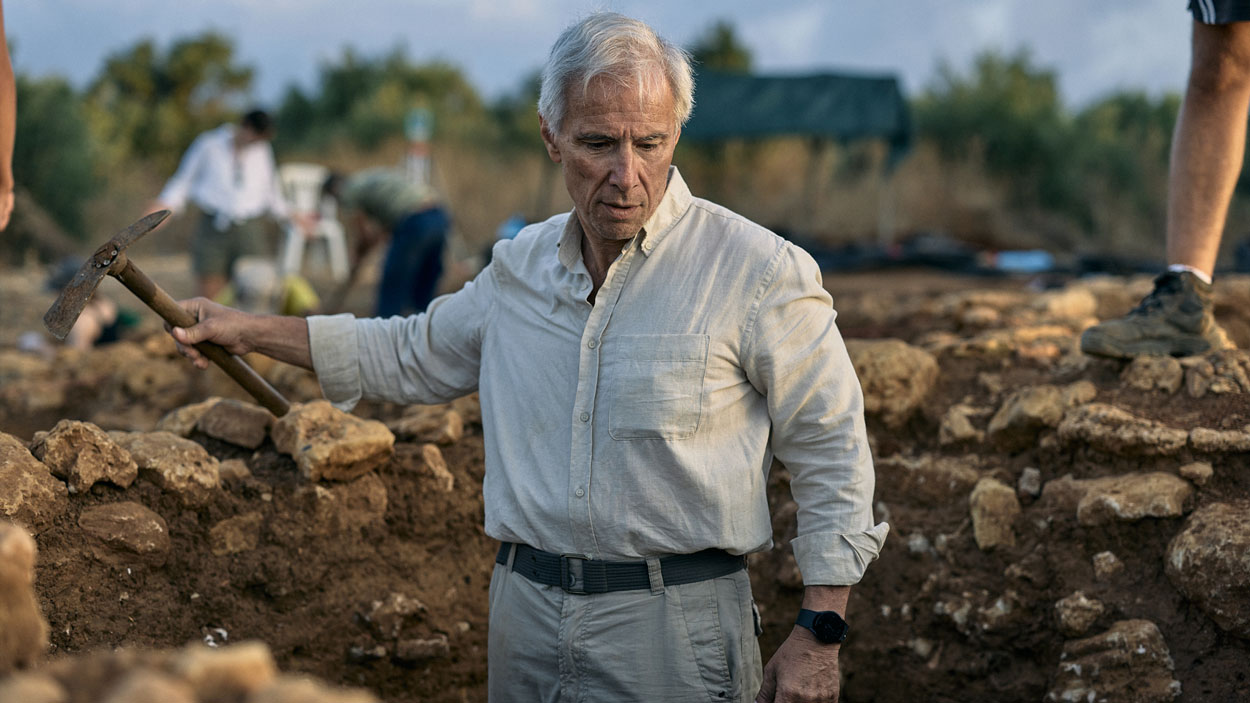
Michael Cosmopoulos, the Hellenic Government-Karakas Foundation Professor in Greek Studies at the University of Missouri–St. Louis, stands in a trench at the Iklaina excavation site in Greece. (Photos courtesy of Michael Cosmopoulos)
Rebecca Bolin never had trouble getting up ahead of the sun this summer in the Peloponnesian Peninsula of southern Greece.
While some college students might have been yawning or wiping the sleep from their eyes at 6 a.m. as they boarded a bus outside their hotel lobby in the coastal town of Pylos, or dozing off again during their roughly half-hour drive along the winding roads that carried them into the countryside, Bolin was always raring to go.
The University of Missouri–St. Louis senior gazed out the window at the rusty red landscape zipping by her window, feeling as if she had been dropped into a magical land she grew up fantasizing about in her childhood.
“I was obsessed with Greek mythology from when I was really young,” Bolin says. “I have some of these myths memorized still to this day.” Bolin, now 26 and majoring in liberal studies with an emphasis in anthropology and sociology, joined students from UMSL and elsewhere in making that drive six days a week for three weeks this summer.
She had the same excitement as that little girl might have had each morning as she stepped off the bus, eager to begin the approximately 15-minute hike uphill, past groves of olive trees, to their ultimate destination, an ancient palace called Iklaina that is referenced in Homer’s Iliad.
The Late Bronze Age capital sat on a plateau in the low hills overlooking the vivid blue waters of the Ionian Sea. It had been lost to time for thousands of years, but for much of the past two decades, it has been the site of an active archaeological excavation being carried out by the Athens Archaeological Society under the direction of Michael Cosmopoulos, the Hellenic Government-Karakas Foundation Professor in Greek Studies at UMSL.
To support the project, Cosmopoulos has received external grant funding totaling more than $700,000 over the years from both federal agencies and private institutions, including the National Science Foundation, National Endowment for the Humanities, Social Sciences and Humanities Research Council of Canada and National Geographic Society.
UMSL coordinates a summer study abroad program that gives students from across the globe the opportunity to do work at the site. From the moment Bolin learned about it, she knew she had to be part of the opportunity.
“I took an anthropology class with Dr. Cosmopoulos on Greek culture, and he told us about the project,” Bolin says. “I was like, ‘Wait, an actual dig? Really? I could do that?’ I knew, ‘Yeah, I have to do that.’ I started preparing for it before I even got an acceptance. I was like, ‘I’m doing this no matter what.’”
***
Since the excavation began in 2006, more than 500 students – including 20 this summer – from UMSL and other institutions in the United States, Canada, Europe and Australia have studied at the field school at Iklaina and culled through the ground in search of new discoveries. They work in trenches, often standing or kneeling and using pickaxes, shovels and trowels to pick away at the dirt and brushes and brooms to clear off some of the dust that has settled there over centuries.
“We have to be very methodical when we are digging and careful when we’re doing it,” Bolin says.
Even when they progress slowly, it can make for taxing work with the dry, rocky ground offering little cushion for their bodies.
“I wish I had been advised to bring some knee pads because the rocks on your knees can be quite painful after a while,” says Frederick McCullough, another of the six UMSL students who worked at the site between June 17 and July 7 this summer. He is a local pastor in his 50s pursuing a bachelor’s degree in sociology with a minor in anthropology.
The crew begins its days early because the terrain at Iklaina provides little relief from the hot summer sun outside of the canopies erected over the trenches. The students follow the direction of trench supervisors, who show them how to recognize soil changes and guide their movements as they take care to leave minimal imprints on the artifacts and ruins they unearth.
Beyond digging, they learn how to identify artifacts; operate the Total Station device to survey the ground; conduct flotation, using water to recover small fragments of material from soil samples; and work in the lab to process and analyze any discoveries. They maintain detailed records of all their activities.
“The students’ contributions are invaluable to our project,” Cosmopoulos says. “On a practical level, their work is crucial because the size of our team directly impacts the number of trenches we can open and the volume of artifacts we can process. This allows us to cover more ground and make more discoveries each season.”
But the students provide intangible traits that are just as important.
“They bring an infectious enthusiasm, humor and passion for archaeology and Greek culture that energizes and inspires the entire team,” Cosmopoulos says. “Their fresh perspectives and eagerness to learn often lead to new insights and ideas, making them an integral part of our research community.”
***
There was palpable excitement and glee the first time each of the students plucked a figurine or piece of pottery from the ground.
“It’s hard not to be excited when you’re holding 3,000-year-old pottery in your hand,” Bolin says. “Sometimes you found something that you weren’t expecting to find, but the main goal was not finding trinkets.”
Rather, they were primarily focused on uncovering the walls to ancient structures built as long ago as 1600 BCE. By studying those buildings, they’re able to glean crucial information about what life was like for people in the Mycenaean civilization.
Iklaina has been providing some of those secrets since 1954, when Greek archaeologist Spyridon Marinatos first visited the site to investigate reports of ancient walls in local farmers’ fields. He spent four days there uncovering parts of some large buildings as well as an unusually large amount of pottery and fragments of wall paintings, but then he left, and the site was almost as quickly forgotten in archaeological circles.
In the 1990s, Professor George Korres – a mentor of Cosmopoulos’ at the University of Athens – brought new attention to Iklaina when he listed it as one of Marinatos’ most significant unfinished projects. Korres recommended Cosmopoulos continue the work.
That prompted the establishment of the Iklaina Archaeological Project, when Cosmopoulos was still a professor of classical studies and anthropology at the University of Manitoba. He began planning a systematic, interdisciplinary excavation of the site.
Cosmopoulos, who had studied archaeology, history and literature as an undergraduate student at the University of Athens and went on to earn his master’s and PhD at Washington University in St. Louis, continued to grow the project after coming to UMSL in 2001.
He was particularly interested in what the site might reveal about the formation of complex states and wanted to understand the processes that led to them first appearing in that part of Greece before later emerging as the dominant political institutions across the western world.
Over the past 15 years, Iklaina has provided plenty of insight on those questions.
In 2009, Cosmopoulos and his team first excavated a mysterious mound on the site and found the buried remains of a Cyclopean limestone terrace. It’s believed to have provided a foundation for a multistory structure typically only found in palaces and Mycenaean capitals.
That led to further investigation using magnetometry and electric resistivity, and they discovered dozens of buildings extending across an area of nearly 32 acres surrounding the terrace, pointing to Iklaina not being merely a confined palace but an entire city, including paved streets and piazzas lined with homes and workshops.
Cosmopoulos’ work in the years since suggests that Iklaina also was part of a two-tiered system of government under the umbrella of the nearby Palace of Nestor. Clay tablets from around 1200 BCE were found at the palace and explicitly mention Iklaina by its ancient name as a district capital in the realm of King Nestor, one of the legendary kings in Homer’s Iliad. The epic poem also contains a reference to Iklaina using that same name.
“The evidence suggests that at some point in its history, Iklaina was integrated into the territory of the Palace of Nestor, while retaining some of its previous autonomy,” says Cosmopoulos, who in June was inducted into the famed Academy of Athens, considered the highest honor scholars can achieve in their chosen fields of study. “This integration likely resulted from a process of violent annexation, where smaller independent states were absorbed into a larger political entity but allowed to maintain a degree of self-governance.”
***
Standing in one of the trenches, brushing dirt loose from the stone walls around him, McCullough started to get a sense of the layout of each structure.
Mycenaean dwellings usually featured a main room in the center called a megaron that was used for receiving visitors or holding feasts or parties, and McCullough found himself imagining what it would have been like to be transported 3,000 years back in time. In his mind, he saw smoke from a central hearth floating up through a hole in the roof. There were people sitting at tables conversing with one another.
“While we can extract and excavate from the ground the things that are in ruin, one thought did come to me – and this is just the musician in me – you can’t extract the sound,” McCullough says. “We will never know exactly the music. We’ll never know the voices. But that gives great opportunity for imagery and imagination – to imagine what the sounds are, to imagine the voices, to imagine the conversations. In doing so, even though I don’t speak Greek, I have to imagine that in a language that perhaps is foreign to me.”
Cosmopoulos hopes students who spend time at the field school will find themselves connecting with the past and with different cultures in that way.
They spend their evenings attending classes and seminars taught by Cosmopoulos and some of his colleagues that focus on archaeological theory and methods as well as Greek history and culture. The students also have opportunities to tour different archaeological sites, including the Palace of Nestor and the Temple of Zeus in Olympia.
There is downtime too at some of the pristine beaches that surround the Ioanian Sea, and they get the chance to interact with locals and dine on regional cuisine.
The local village even hosted a festival for the students and the rest of the crew on one of their last nights there this summer.
“They all came together and made these traditional foods from scratch, and got singers, and they would dance till all hours of the night,” Bolin says. “When you were there, you danced. It didn’t matter where you came from or who you were. If you were there, you were considered part of the group, and you danced.”
Cosmopoulos believes those exchanges are a crucial part of the experience for students.
“Ultimately, we hope this experience not only enhances their academic and professional skills,” he says, “but also broadens their worldview and creates lasting memories.”
***
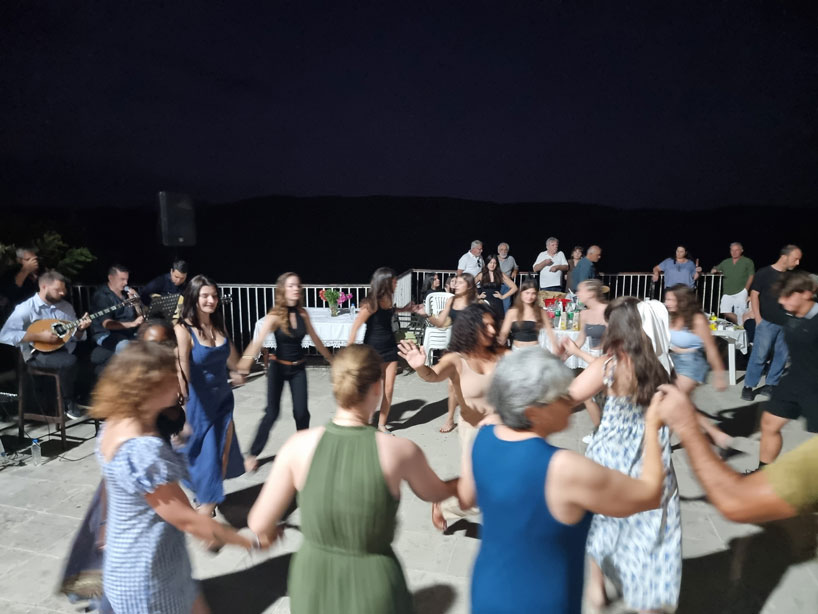
Students dance at a celebration organized for them in the local village. It was a chance for the students to interact with local people and experience the culture.
Bolin remains grateful for Cosmopoulos’ help securing funding from the National Science Foundation through its Research Experiences for Undergraduates program. It’s what made her summer at Iklaina possible.
“I wouldn’t trade it for the world,” Bolin says. “I’d do it again and again and again. It gave me a new look on life. I knew that was going to happen when I left, that this was going to be an experience that changes things.”
She’s already plotting a way to return. She plans to spend the academic year working in the Nicholas and Theodora Matsakis Hellenic Culture Center at UMSL while she completes her bachelor’s degree. She’d like next to pursue a master’s degree in history with an emphasis in museums, heritage and public history and work on another excavation.
McCullough, meanwhile, has already updated his Facebook page to read “retired” from the Iklaina Archaeological Project. But he’s no less appreciative than Bolin for having gone through the experience or what he carried away from it.
“I think every college student, whenever possible, should find a study abroad program,” McCullough says. “My recommendation is going to always be Greece and this particular program because there’s so much more information that you are able to glean, other than the practice of excavating. There are historical dynamics. There’s the appreciation of the mechanics that go along with it, the science of it. And it’s well-rounded. If you go with an open mind, you can see how it applies to anything that you may be pursuing academically. It’s enriching and enlightening and very exciting.”
This story was originally published in the fall 2024 issue of UMSL Magazine. If you have a story idea for UMSL Magazine, email magazine@umsl.edu.

